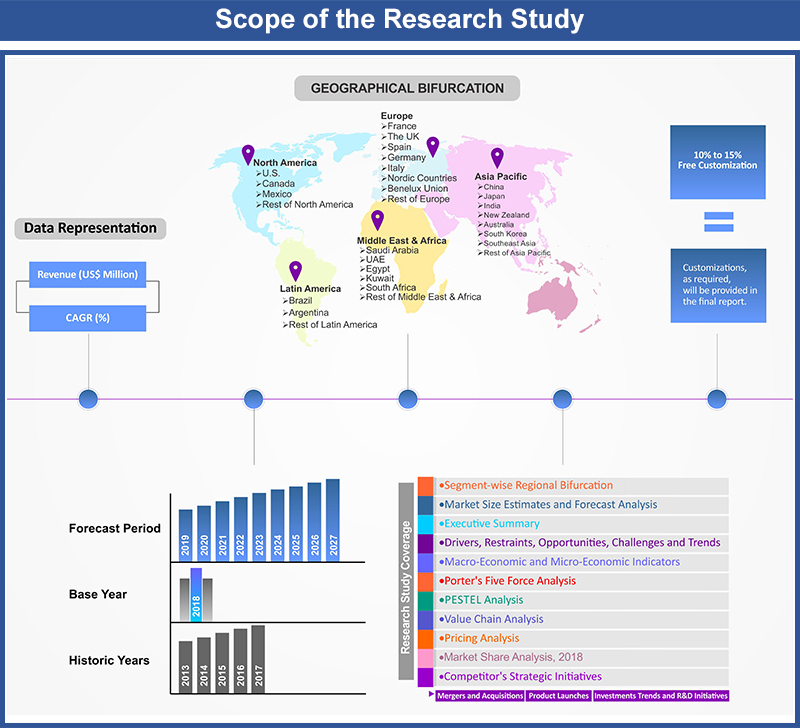Healthcare Cloud Computing Market By Component (Software, Hardware and Services), By Deployment Mode (Private Cloud, Public Cloud, Hybrid Cloud, Community Cloud), By Pricing Models (Spot Pricing/Subscription Model and Pay-as-you-go Model), By Service Model (Software as a Service (SaaS), Platform as a Service (PaaS) and Infrastructure as a Service (IaaS)) By Application (Clinical Information System and Non-Clinical Information System) By End User (Healthcare Providers and Healthcare Payers) – United States Insights, Growth, Size, Comparative Analysis, Trends and Forecast, 2019 – 2027
Industry Trends
United States healthcare cloud computing market was valued at US$ 7,139.8 million in 2018 and is expected to reach US$ 30,232 million by 2027, growing at an estimated CAGR of 17.4% over the forecast period. The cloud-based platforms enable real-time collaboration between healthcare providers that results in data management with more agility among healthcare organizations. Usage of cloud services not only contributes to faster data management but also exhibits efficient monitoring of chronic diseases. Such a factor has aided the overall market in recent past and is expected to continue the same trend over the forecast period.
The healthcare providers generate huge amount of data from various sources that commonly include radiology images, electronic medical records, lab tests, prescription information, and pharmacy sales amongst others. The volume of all these data are increasing exponentially every year owing to the changes in the payer environment. The technological advancements is also resulting in the generation of large volume of healthcare data. Patients and also common individuals are employing chronic disease monitoring devices such as glucose trackers for diabetes that results in maintaining huge amount of data by the healthcare providers. Such a factor is expected to drive the cloud computing market over the next eight years. However, Violation of patient confidentiality carries heavy fines that incur significant costs of recovery and patient notification. Such a factor is expected to critically affect the healthcare cloud computing market growth. A potential solution has been identified for the same, wherein private cloud model can be used that stores the information at the customer data center and a certain degree of confidentiality still exists for organizations to manage patient privacy.
The service segment accounted over 50% of the overall market and is expected to grow with highest CAGR of 17.6% over the forecast period. Owing to factors such as support and maintenance, training and education, installation and upgrades, the service segment is expected to witness considerable growth from 2019 to 2027.
In terms of revenue, private cloud segment accounted 52.3% in 2018 and is expected to reach USD 16,547.1 million by 2027, growing at a CAGR of 17.9% over the forecast period. Private cloud provides the control and visibility to healthcare organization over their data. The private cloud is mainly deployed within organizations security protocols. Also, on premise private cloud offers healthcare organizations options which are attractive when it comes to control the network. The method is most appropriate for large organizations that have a large base of IT staff and security expertise.
Software as a Service (SaaS) segment in healthcare cloud computing market accounted over 55% in 2018 and is expected to reach at USD 19,932.9 million by 2027. Owing to features such as cost effectiveness, security advantages, increased collaboration & mobility and scalability, the concerned applications are increasingly used by healthcare organizations in the recent past.
The clinical information system in healthcare cloud computing market is projected to witness a CAGR of 17.0% over the forecast period. The same is developed for the aim of improving the patient’s quality of care and efficiency. It reduces the chances of error and are used in various forms such as radiology information systems, electronic medical records, laboratory information systems, computerized physician order entry and pharmacy information systems. In recent years, it has been reported that clinical information system can be duly integrated with handheld devices and ambulatory care records for reviewing and collecting data, support programs and decision tools.
Healthcare providers accounted a major share in 2018 and is expected to continue the same trend over the next eight years. It has been reported in the recent years that on-demand cloud computing & storage technically reduces operational costs for clinics and hospitals. The application of cloud computing contributes to streamlined execution of job responsibilities for the providers as well as the hospital staff. This in turn enables to achieve significant cost savings. Such a factor is expected to aid the United States healthcare cloud computing market over the forecast period.
a cloud computing system is a measured service that has the ability to analyse and control resource usage in regards to the type of service provided e.g., storage and processing. Most healthcare practitioners and institutions still rely on paper medical records, thus limiting collaboration and coordination between patients and physicians. Most healthcare practitioners and institutions still rely on paper medical records, thus limiting collaboration and coordination between patients and physicians. Most healthcare practitioners and institutions still rely on paper medical records, thus limiting collaboration and coordination between patients and physicians. Most healthcare practitioners and institutions still rely on paper medical records, thus limiting collaboration and coordination between patients and physicians.
United States Healthcare Cloud Computing Market Revenue & Forecast, (US$ Million), 2015 – 2027
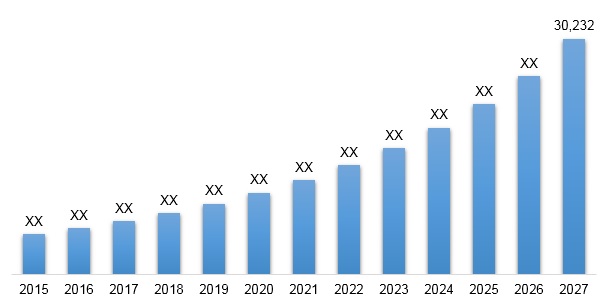
Competitive Landscape
The report provides both, qualitative and quantitative research of patient recliners market, market, as well as provides comprehensive insights and favored development methods adopted by the key contenders. The Healthcare Cloud Computing market report also offers extensive research on the key players in this market and details on the competitiveness of these players. Key business strategies such as mergers and acquisitions (M&A), affiliations, collaborations, and contracts adopted by these major market participants are also recognized and analyzed in the report. For each company, the report studies regional presence, competitors, service offerings, specification, pricing, and gross margin.
Some of the players operating in the healthcare cloud computing market are athenahealth, Inc, CareCloud Corporation., Carestream Health, Cerner Corporation., ClearDATA, CLOUDMINE, INC, INFINITT HealthcareCo., LTD, amongst others.
Healthcare Cloud Computing Market:
- By Component
- Software
- Hardware
- Services
- By Deployment Mode
- Private Cloud
- Public Cloud
- Hybrid Cloud
- Community Cloud
- By Pricing Models
- Spot Pricing/Subscription Model
- Pay-as-you-go Model
- By Service Model
- Software as a Service (SaaS)
- Platform as a Service (PaaS)
- Infrastructure as a Service (IaaS)
- By Application
- Clinical Information System
- Non-Clinical Information System
- By End User
- Healthcare Providers
- Healthcare Payers
- By Region
- North East
- Midwest
- South
- West
1. Market Scope
1.1. Market
Segmentation
1.2. Years
Considered
1.2.1. Historic
Years: 2013 - 2017
1.2.2. Base
Year: 2018
1.2.3. Forecast
Years: 2019 – 2027
2. Key Target Audiences
3. Research Methodology
3.1. Primary
Research
3.1.1. Research
Questionnaire
3.1.2. United
States Percentage Breakdown
3.1.3. Primary
Interviews: Key Opinion Leaders (KOLs)
3.2. Secondary
Research
3.2.1. Paid
Databases
3.2.2. Secondary
Sources
3.3. Market
Size Estimates
3.3.1. Top-Down
Approach
3.3.2. Bottom-Up
Approach
3.4. Data
Triangulation Methodology
3.5. Research
Assumptions
4. Recommendations and Insights from AMI’s Perspective**
5. Holistic Overview of Healthcare Cloud Computing Market
6. Market Synopsis:
Healthcare Cloud Computing Market
7. Healthcare Cloud Computing Market Analysis: Qualitative
Perspective
7.1. Introduction
7.1.1. Product
Definition
7.1.2. Industry
Development
7.2. Market
Dynamics
7.2.1. Drivers
7.2.2. Restraints
7.2.3. Opportunities
7.3. Trends in
Healthcare Cloud Computing Market
7.4. Market
Determinants Radar Chart
7.5. Macro-Economic
and Micro-Economic Indicators: Healthcare Cloud Computing Market
7.6.
Porter’s Five Force
Analysis
8. United States Healthcare Cloud Computing Market Analysis and
Forecasts, 2019 – 2027
8.1. Overview
8.1.1. United
States Healthcare Cloud Computing Market Revenue (US$ Mn)
8.2. United
States Healthcare Cloud Computing Market Revenue (US$ Mn) and Forecasts, By Component
8.2.1. Software
8.2.1.1. Definition
8.2.1.2. Market
Penetration, 2018
8.2.1.3. Market
Estimation, 2013 – 2018
8.2.1.4. Market
Forecast, 2019 – 2027
8.2.1.5. Compound
Annual Growth Rate (CAGR)
8.2.1.6. Regional
Bifurcation
8.2.1.6.1. Northeast
8.2.1.6.1.1. Market
Estimation, 2013 – 2018
8.2.1.6.1.2. Market
Forecast, 2019 – 2027
8.2.1.6.2. Midwest
8.2.1.6.2.1. Market
Estimation, 2013 – 2018
8.2.1.6.2.2. Market
Forecast, 2019 – 2027
8.2.1.6.3. South
8.2.1.6.3.1. Market
Estimation, 2013 – 2018
8.2.1.6.3.2. Market
Forecast, 2019 – 2027
8.2.1.6.4. West
8.2.1.6.4.1. Market
Estimation, 2013 – 2018
8.2.1.6.4.2. Market
Forecast, 2019 – 2027
8.2.2. Hardware
8.2.2.1. Definition
8.2.2.2. Market
Penetration, 2018
8.2.2.3. Market
Estimation, 2013 – 2018
8.2.2.4. Market
Forecast, 2019 – 2027
8.2.2.5. Compound
Annual Growth Rate (CAGR)
8.2.2.6. Regional
Bifurcation
8.2.2.6.1. Northeast
8.2.2.6.1.1. Market
Estimation, 2013 – 2018
8.2.2.6.1.2. Market
Forecast, 2019 – 2027
8.2.2.6.2. Midwest
8.2.2.6.2.1. Market
Estimation, 2013 – 2018
8.2.2.6.2.2. Market
Forecast, 2019 – 2027
8.2.2.6.3. South
8.2.2.6.3.1. Market
Estimation, 2013 – 2018
8.2.2.6.3.2. Market
Forecast, 2019 – 2027
8.2.2.6.4. West
8.2.2.6.4.1. Market
Estimation, 2013 – 2018
8.2.2.6.4.2. Market
Forecast, 2019 – 2027
8.2.3. Services
8.2.3.1. Definition
8.2.3.2. Market
Penetration, 2018
8.2.3.3. Market
Estimation, 2013 – 2018
8.2.3.4. Market
Forecast, 2019 – 2027
8.2.3.5. Compound
Annual Growth Rate (CAGR)
8.2.3.6. Regional
Bifurcation
8.2.3.6.1. Northeast
8.2.3.6.1.1. Market
Estimation, 2013 – 2018
8.2.3.6.1.2. Market
Forecast, 2019 – 2027
8.2.3.6.2. Midwest
8.2.3.6.2.1. Market
Estimation, 2013 – 2018
8.2.3.6.2.2. Market
Forecast, 2019 – 2027
8.2.3.6.3. South
8.2.3.6.3.1. Market
Estimation, 2013 – 2018
8.2.3.6.3.2. Market
Forecast, 2019 – 2027
8.2.3.6.4. West
8.2.3.6.4.1. Market
Estimation, 2013 – 2018
8.2.3.6.4.2. Market
Forecast, 2019 – 2027
8.3. Key
Segment for Channeling Investments
8.3.1. By
Component
9. United States Healthcare Cloud Computing Market Analysis and
Forecasts, 2019 – 2027
9.1. Overview
9.2. United
States Healthcare Cloud Computing Market Revenue (US$ Mn) and Forecasts, By Deployment Mode
9.2.1. Private
Cloud
9.2.1.1. Definition
9.2.1.2. Market
Penetration, 2018
9.2.1.3. Market
Estimation, 2013 – 2018
9.2.1.4. Market
Forecast, 2019 – 2027
9.2.1.5. Compound
Annual Growth Rate (CAGR)
9.2.1.6. Regional
Bifurcation
9.2.1.6.1. Northeast
9.2.1.6.1.1. Market
Estimation, 2013 – 2018
9.2.1.6.1.2. Market
Forecast, 2019 – 2027
9.2.1.6.2. Midwest
9.2.1.6.2.1. Market
Estimation, 2013 – 2018
9.2.1.6.2.2. Market
Forecast, 2019 – 2027
9.2.1.6.3. South
9.2.1.6.3.1. Market
Estimation, 2013 – 2018
9.2.1.6.3.2. Market
Forecast, 2019 – 2027
9.2.1.6.4. West
9.2.1.6.4.1. Market
Estimation, 2013 – 2018
9.2.1.6.4.2. Market
Forecast, 2019 – 2027
9.2.2. Public
Cloud
9.2.2.1. Definition
9.2.2.2. Market
Penetration, 2018
9.2.2.3. Market
Estimation, 2013 – 2018
9.2.2.4. Market
Forecast, 2019 – 2027
9.2.2.5. Compound
Annual Growth Rate (CAGR)
9.2.2.6. Regional
Bifurcation
9.2.2.6.1. Northeast
9.2.2.6.1.1. Market
Estimation, 2013 – 2018
9.2.2.6.1.2. Market
Forecast, 2019 – 2027
9.2.2.6.2. Midwest
9.2.2.6.2.1. Market
Estimation, 2013 – 2018
9.2.2.6.2.2. Market
Forecast, 2019 – 2027
9.2.2.6.3. South
9.2.2.6.3.1. Market
Estimation, 2013 – 2018
9.2.2.6.3.2. Market
Forecast, 2019 – 2027
9.2.2.6.4. West
9.2.2.6.4.1. Market
Estimation, 2013 – 2018
9.2.2.6.4.2. Market
Forecast, 2019 – 2027
9.2.3. Hybrid
Cloud
9.2.3.1. Definition
9.2.3.2. Market
Penetration, 2018
9.2.3.3. Market
Estimation, 2013 – 2018
9.2.3.4. Market
Forecast, 2019 – 2027
9.2.3.5. Compound
Annual Growth Rate (CAGR)
9.2.3.6. Regional
Bifurcation
9.2.3.6.1. Northeast
9.2.3.6.1.1. Market
Estimation, 2013 – 2018
9.2.3.6.1.2. Market
Forecast, 2019 – 2027
9.2.3.6.2. Midwest
9.2.3.6.2.1. Market
Estimation, 2013 – 2018
9.2.3.6.2.2. Market
Forecast, 2019 – 2027
9.2.3.6.3. South
9.2.3.6.3.1. Market
Estimation, 2013 – 2018
9.2.3.6.3.2. Market
Forecast, 2019 – 2027
9.2.3.6.4. West
9.2.3.6.4.1. Market
Estimation, 2013 – 2018
9.2.3.6.4.2. Market
Forecast, 2019 – 2027
9.2.4. Community
Cloud
9.2.4.1. Definition
9.2.4.2. Market
Penetration, 2018
9.2.4.3. Market
Estimation, 2013 – 2018
9.2.4.4. Market
Forecast, 2019 – 2027
9.2.4.5. Compound
Annual Growth Rate (CAGR)
9.2.4.6. Regional
Bifurcation
9.2.4.6.1. Northeast
9.2.4.6.1.1. Market
Estimation, 2013 – 2018
9.2.4.6.1.2. Market
Forecast, 2019 – 2027
9.2.4.6.2. Midwest
9.2.4.6.2.1. Market
Estimation, 2013 – 2018
9.2.4.6.2.2. Market
Forecast, 2019 – 2027
9.2.4.6.3. South
9.2.4.6.3.1. Market
Estimation, 2013 – 2018
9.2.4.6.3.2. Market
Forecast, 2019 – 2027
9.2.4.6.4. West
9.2.4.6.4.1. Market
Estimation, 2013 – 2018
9.2.4.6.4.2. Market
Forecast, 2019 – 2027
9.3. Key
Segment for Channeling Investments
9.3.1. By
Deployment Mode
10. United States Healthcare Cloud Computing Market Analysis and Forecasts,
2019 – 2027
10.1. Overview
10.2. United
States Healthcare Cloud Computing Market Revenue (US$ Mn) and Forecasts, By Pricing Models
10.2.1. Spot
Pricing/Subscription Model
10.2.1.1. Definition
10.2.1.2. Market
Penetration, 2018
10.2.1.3. Market
Estimation, 2013 – 2018
10.2.1.4. Market
Forecast, 2019 – 2027
10.2.1.5. Compound
Annual Growth Rate (CAGR)
10.2.1.6. Regional
Bifurcation
10.2.1.6.1. Northeast
10.2.1.6.1.1. Market
Estimation, 2013 – 2018
10.2.1.6.1.2. Market
Forecast, 2019 – 2027
10.2.1.6.2. Midwest
10.2.1.6.2.1. Market
Estimation, 2013 – 2018
10.2.1.6.2.2. Market
Forecast, 2019 – 2027
10.2.1.6.3. South
10.2.1.6.3.1. Market
Estimation, 2013 – 2018
10.2.1.6.3.2. Market
Forecast, 2019 – 2027
10.2.1.6.4. West
10.2.1.6.4.1. Market
Estimation, 2013 – 2018
10.2.1.6.4.2. Market
Forecast, 2019 – 2027
10.2.2. Pay-as-you-go
Model
10.2.2.1. Definition
10.2.2.2. Market
Penetration, 2018
10.2.2.3. Market
Estimation, 2013 – 2018
10.2.2.4. Market
Forecast, 2019 – 2027
10.2.2.5. Compound
Annual Growth Rate (CAGR)
10.2.2.6. Regional
Bifurcation
10.2.2.6.1. Northeast
10.2.2.6.1.1. Market
Estimation, 2013 – 2018
10.2.2.6.1.2. Market
Forecast, 2019 – 2027
10.2.2.6.2. Midwest
10.2.2.6.2.1. Market
Estimation, 2013 – 2018
10.2.2.6.2.2. Market
Forecast, 2019 – 2027
10.2.2.6.3. South
10.2.2.6.3.1. Market
Estimation, 2013 – 2018
10.2.2.6.3.2. Market
Forecast, 2019 – 2027
10.2.2.6.4. West
10.2.2.6.4.1. Market
Estimation, 2013 – 2018
10.2.2.6.4.2. Market
Forecast, 2019 – 2027
10.3. Key
Segment for Channeling Investments
10.3.1. By
Pricing Models
11. United States Healthcare Cloud Computing Market Analysis and
Forecasts, 2019 – 2027
11.1. Overview
11.2. United
States Healthcare Cloud Computing Market Revenue (US$ Mn) and Forecasts, By Service Model
11.2.1. Software
as a Service (SaaS)
11.2.1.1. Definition
11.2.1.2. Market
Penetration, 2018
11.2.1.3. Market
Estimation, 2013 – 2018
11.2.1.4. Market
Forecast, 2019 – 2027
11.2.1.5. Compound
Annual Growth Rate (CAGR)
11.2.1.6. Regional
Bifurcation
11.2.1.6.1. Northeast
11.2.1.6.1.1. Market
Estimation, 2013 – 2018
11.2.1.6.1.2. Market
Forecast, 2019 – 2027
11.2.1.6.2. Midwest
11.2.1.6.2.1. Market
Estimation, 2013 – 2018
11.2.1.6.2.2. Market
Forecast, 2019 – 2027
11.2.1.6.3. South
11.2.1.6.3.1. Market
Estimation, 2013 – 2018
11.2.1.6.3.2. Market
Forecast, 2019 – 2027
11.2.1.6.4. West
11.2.1.6.4.1. Market
Estimation, 2013 – 2018
11.2.1.6.4.2. Market
Forecast, 2019 – 2027
11.2.2. Platform
as a Service (PaaS)
11.2.2.1. Definition
11.2.2.2. Market
Penetration, 2018
11.2.2.3. Market
Estimation, 2013 – 2018
11.2.2.4. Market
Forecast, 2019 – 2027
11.2.2.5. Compound
Annual Growth Rate (CAGR)
11.2.2.6. Regional
Bifurcation
11.2.2.6.1. Northeast
11.2.2.6.1.1. Market
Estimation, 2013 – 2018
11.2.2.6.1.2. Market
Forecast, 2019 – 2027
11.2.2.6.2. Midwest
11.2.2.6.2.1. Market
Estimation, 2013 – 2018
11.2.2.6.2.2. Market
Forecast, 2019 – 2027
11.2.2.6.3. South
11.2.2.6.3.1. Market
Estimation, 2013 – 2018
11.2.2.6.3.2. Market
Forecast, 2019 – 2027
11.2.2.6.4. West
11.2.2.6.4.1. Market
Estimation, 2013 – 2018
11.2.2.6.4.2. Market
Forecast, 2019 – 2027
11.2.3. Infrastructure
as a Service (IaaS)
11.2.3.1. Definition
11.2.3.2. Market
Penetration, 2018
11.2.3.3. Market
Estimation, 2013 – 2018
11.2.3.4. Market
Forecast, 2019 – 2027
11.2.3.5. Compound
Annual Growth Rate (CAGR)
11.2.3.6. Regional
Bifurcation
11.2.3.6.1. Northeast
11.2.3.6.1.1. Market
Estimation, 2013 – 2018
11.2.3.6.1.2. Market
Forecast, 2019 – 2027
11.2.3.6.2. Midwest
11.2.3.6.2.1. Market
Estimation, 2013 – 2018
11.2.3.6.2.2. Market
Forecast, 2019 – 2027
11.2.3.6.3. South
11.2.3.6.3.1. Market
Estimation, 2013 – 2018
11.2.3.6.3.2. Market
Forecast, 2019 – 2027
11.2.3.6.4. West
11.2.3.6.4.1. Market
Estimation, 2013 – 2018
11.2.3.6.4.2. Market
Forecast, 2019 – 2027
11.3. Key
Segment for Channeling Investments
11.3.1. By
Service Model
12. United States Healthcare Cloud Computing Market Analysis and
Forecasts, 2019 – 2027
12.1. Overview
12.2. United
States Healthcare Cloud Computing Market Revenue (US$ Mn) and Forecasts, By Application
12.2.1. Clinical
Information System
12.2.1.1. Definition
12.2.1.2. Market
Penetration, 2018
12.2.1.3. Market
Estimation, 2013 – 2018
12.2.1.4. Market
Forecast, 2019 – 2027
12.2.1.5. Compound
Annual Growth Rate (CAGR)
12.2.1.6. Regional
Bifurcation
12.2.1.6.1. Northeast
12.2.1.6.1.1. Market
Estimation, 2013 – 2018
12.2.1.6.1.2. Market
Forecast, 2019 – 2027
12.2.1.6.2. Midwest
12.2.1.6.2.1. Market
Estimation, 2013 – 2018
12.2.1.6.2.2. Market
Forecast, 2019 – 2027
12.2.1.6.3. South
12.2.1.6.3.1. Market
Estimation, 2013 – 2018
12.2.1.6.3.2. Market
Forecast, 2019 – 2027
12.2.1.6.4. West
12.2.1.6.4.1. Market
Estimation, 2013 – 2018
12.2.1.6.4.2. Market
Forecast, 2019 – 2027
12.2.2. Non-Clinical
Information System
12.2.2.1. Definition
12.2.2.2. Market
Penetration, 2018
12.2.2.3. Market
Estimation, 2013 – 2018
12.2.2.4. Market
Forecast, 2019 – 2027
12.2.2.5. Compound
Annual Growth Rate (CAGR)
12.2.2.6. Regional
Bifurcation
12.2.2.6.1. Northeast
12.2.2.6.1.1. Market
Estimation, 2013 – 2018
12.2.2.6.1.2. Market
Forecast, 2019 – 2027
12.2.2.6.2. Midwest
12.2.2.6.2.1. Market
Estimation, 2013 – 2018
12.2.2.6.2.2. Market
Forecast, 2019 – 2027
12.2.2.6.3. South
12.2.2.6.3.1. Market
Estimation, 2013 – 2018
12.2.2.6.3.2. Market
Forecast, 2019 – 2027
12.2.2.6.4. West
12.2.2.6.4.1. Market
Estimation, 2013 – 2018
12.2.2.6.4.2. Market
Forecast, 2019 – 2027
12.3. Key
Segment for Channeling Investments
12.3.1. By
Application
13. United States Healthcare Cloud Computing Market Analysis and
Forecasts, 2019 – 2027
13.1. Overview
13.2. United
States Healthcare Cloud Computing Market Revenue (US$ Mn) and Forecasts, By End User
13.2.1. Healthcare
Providers
13.2.1.1. Definition
13.2.1.2. Market
Penetration, 2018
13.2.1.3. Market
Estimation, 2013 – 2018
13.2.1.4. Market
Forecast, 2019 – 2027
13.2.1.5. Compound
Annual Growth Rate (CAGR)
13.2.1.6. Regional
Bifurcation
13.2.1.6.1. Northeast
13.2.1.6.1.1. Market
Estimation, 2013 – 2018
13.2.1.6.1.2. Market
Forecast, 2019 – 2027
13.2.1.6.2. Midwest
13.2.1.6.2.1. Market
Estimation, 2013 – 2018
13.2.1.6.2.2. Market
Forecast, 2019 – 2027
13.2.1.6.3. South
13.2.1.6.3.1. Market
Estimation, 2013 – 2018
13.2.1.6.3.2. Market
Forecast, 2019 – 2027
13.2.1.6.4. West
13.2.1.6.4.1. Market
Estimation, 2013 – 2018
13.2.1.6.4.2. Market
Forecast, 2019 – 2027
13.2.2. Healthcare
Payers
13.2.2.1. Definition
13.2.2.2. Market
Penetration, 2018
13.2.2.3. Market
Estimation, 2013 – 2018
13.2.2.4. Market
Forecast, 2019 – 2027
13.2.2.5. Compound
Annual Growth Rate (CAGR)
13.2.2.6. Regional
Bifurcation
13.2.2.6.1. Northeast
13.2.2.6.1.1. Market
Estimation, 2013 – 2018
13.2.2.6.1.2. Market
Forecast, 2019 – 2027
13.2.2.6.2. Midwest
13.2.2.6.2.1. Market
Estimation, 2013 – 2018
13.2.2.6.2.2. Market
Forecast, 2019 – 2027
13.2.2.6.3. South
13.2.2.6.3.1. Market
Estimation, 2013 – 2018
13.2.2.6.3.2. Market
Forecast, 2019 – 2027
13.2.2.6.4. West
13.2.2.6.4.1. Market
Estimation, 2013 – 2018
13.2.2.6.4.2. Market
Forecast, 2019 – 2027
13.3. Key
Segment for Channeling Investments
13.3.1. By End
User
14. United States Healthcare Cloud Computing Market Analysis and
Forecasts, 2019 – 2027
14.1. Overview
14.2. United
States Healthcare Cloud Computing Market Revenue (US$ Mn) and Forecasts By
Region
14.2.1. Northeast
14.2.1.1. Northeast
Healthcare Cloud Computing Market Revenue (US$ Mn) and Forecasts, By Component
14.2.1.1.1. Software
14.2.1.1.2. Hardware
14.2.1.1.3. Services
14.2.1.2. Northeast
Healthcare Cloud Computing Market Revenue (US$ Mn) and Forecasts, By Deployment
Mode
14.2.1.2.1. Private
Cloud
14.2.1.2.2. Public
Cloud
14.2.1.2.3. Hybrid
Cloud
14.2.1.2.4. Community
Cloud
14.2.1.3. Northeast
Healthcare Cloud Computing Market Revenue (US$ Mn) and Forecasts, By Pricing
Models
14.2.1.3.1. Spot
Pricing/Subscription Model
14.2.1.3.2. Pay-as-you-go
Model
14.2.1.4. Northeast
Healthcare Cloud Computing Market Revenue (US$ Mn) and Forecasts, By Service
Model
14.2.1.4.1. Software
as a Service (SaaS)
14.2.1.4.2. Platform
as a Service (PaaS)
14.2.1.4.3. Infrastructure
as a Service (IaaS)
14.2.1.5. Northeast
Healthcare Cloud Computing Market Revenue (US$ Mn) and Forecasts, By
Application
14.2.1.5.1. Clinical
Information System
14.2.1.5.2. Non-Clinical
Information System
14.2.1.6. Northeast
Healthcare Cloud Computing Market Revenue (US$ Mn) and Forecasts, By End User
14.2.1.6.1. Healthcare
Providers
14.2.1.6.2. Healthcare
Payers
14.2.2. Midwest
14.2.2.1. Midwest
Healthcare Cloud Computing Market Revenue (US$ Mn) and Forecasts, By Component
14.2.2.1.1. Software
14.2.2.1.2. Hardware
14.2.2.1.3. Services
14.2.2.2. Midwest
Healthcare Cloud Computing Market Revenue (US$ Mn) and Forecasts, By Deployment
Mode
14.2.2.2.1. Private
Cloud
14.2.2.2.2. Public
Cloud
14.2.2.2.3. Hybrid
Cloud
14.2.2.2.4. Community
Cloud
14.2.2.3. Midwest
Healthcare Cloud Computing Market Revenue (US$ Mn) and Forecasts, By Pricing
Models
14.2.2.3.1. Spot
Pricing/Subscription Model
14.2.2.3.2. Pay-as-you-go
Model
14.2.2.4. Midwest
Healthcare Cloud Computing Market Revenue (US$ Mn) and Forecasts, By Service
Model
14.2.2.4.1. Software
as a Service (SaaS)
14.2.2.4.2. Platform
as a Service (PaaS)
14.2.2.4.3. Infrastructure
as a Service (IaaS)
14.2.2.5. Midwest
Healthcare Cloud Computing Market Revenue (US$ Mn) and Forecasts, By
Application
14.2.2.5.1. Clinical
Information System
14.2.2.5.2. Non-Clinical
Information System
14.2.2.6. Midwest
Healthcare Cloud Computing Market Revenue (US$ Mn) and Forecasts, By End User
14.2.2.6.1. Healthcare
Providers
14.2.2.6.2. Healthcare
Payers
14.2.3. South
14.2.3.1. South
Healthcare Cloud Computing Market Revenue (US$ Mn) and Forecasts, By Component
14.2.3.1.1. Software
14.2.3.1.2. Hardware
14.2.3.1.3. Services
14.2.3.2. South
Healthcare Cloud Computing Market Revenue (US$ Mn) and Forecasts, By Deployment
Mode
14.2.3.2.1. Private
Cloud
14.2.3.2.2. Public
Cloud
14.2.3.2.3. Hybrid
Cloud
14.2.3.2.4. Community
Cloud
14.2.3.3. South
Healthcare Cloud Computing Market Revenue (US$ Mn) and Forecasts, By Pricing
Models
14.2.3.3.1. Spot
Pricing/Subscription Model
14.2.3.3.2. Pay-as-you-go
Model
14.2.3.4. South
Healthcare Cloud Computing Market Revenue (US$ Mn) and Forecasts, By Service
Model
14.2.3.4.1. Software
as a Service (SaaS)
14.2.3.4.2. Platform
as a Service (PaaS)
14.2.3.4.3. Infrastructure
as a Service (IaaS)
14.2.3.5. South
Healthcare Cloud Computing Market Revenue (US$ Mn) and Forecasts, By
Application
14.2.3.5.1. Clinical
Information System
14.2.3.5.2. Non-Clinical
Information System
14.2.3.6. South
Healthcare Cloud Computing Market Revenue (US$ Mn) and Forecasts, By End User
14.2.3.6.1. Healthcare
Providers
14.2.3.6.2. Healthcare
Payers
14.2.4. West
14.2.4.1. West
Healthcare Cloud Computing Market Revenue (US$ Mn) and Forecasts, By Component
14.2.4.1.1. Software
14.2.4.1.2. Hardware
14.2.4.1.3. Services
14.2.4.2. West
Healthcare Cloud Computing Market Revenue (US$ Mn) and Forecasts, By Deployment
Mode
14.2.4.2.1. Private
Cloud
14.2.4.2.2. Public
Cloud
14.2.4.2.3. Hybrid
Cloud
14.2.4.2.4. Community
Cloud
14.2.4.3. West
Healthcare Cloud Computing Market Revenue (US$ Mn) and Forecasts, By Pricing
Models
14.2.4.3.1. Spot
Pricing/Subscription Model
14.2.4.3.2. Pay-as-you-go
Model
14.2.4.4. West
Healthcare Cloud Computing Market Revenue (US$ Mn) and Forecasts, By Service
Model
14.2.4.4.1. Software
as a Service (SaaS)
14.2.4.4.2. Platform
as a Service (PaaS)
14.2.4.4.3. Infrastructure
as a Service (IaaS)
14.2.4.5. West
Healthcare Cloud Computing Market Revenue (US$ Mn) and Forecasts, By
Application
14.2.4.5.1. Clinical
Information System
14.2.4.5.2. Non-Clinical
Information System
14.2.4.6. West
Healthcare Cloud Computing Market Revenue (US$ Mn) and Forecasts, By End User
14.2.4.6.1. Healthcare
Providers
14.2.4.6.2. Healthcare
Payers
15. Competitive Benchmarking
15.1. Market
Share Analysis, 2018
15.2. United
States Presence and Growth Strategies
15.2.1. Mergers
and Acquisitions
15.2.2. Product
Launches
15.2.3. Investments
Trends
15.2.4. R&D
Initiatives
16. Player Profiles
16.1. athenahealth,
Inc.
16.1.1. Company
Details
16.1.2. Company
Overview
16.1.3. Product
Offerings
16.1.4. Key
Developments
16.1.5. Financial
Analysis
16.1.6. SWOT
Analysis
16.1.7. Business
Strategies
16.2. Carecloud
Corporation
16.2.1. Company
Details
16.2.2. Company
Overview
16.2.3. Product
Offerings
16.2.4. Key
Developments
16.2.5. Financial
Analysis
16.2.6. SWOT
Analysis
16.2.7. Business
Strategies
16.3. CarestreamHealth,
Inc.
16.3.1. Company
Details
16.3.2. Company
Overview
16.3.3. Product
Offerings
16.3.4. Key
Developments
16.3.5. Financial
Analysis
16.3.6. SWOT
Analysis
16.3.7. Business
Strategies
16.4. Cerner
Corporation
16.4.1. Company
Details
16.4.2. Company
Overview
16.4.3. Product
Offerings
16.4.4. Key
Developments
16.4.5. Financial
Analysis
16.4.6. SWOT
Analysis
16.4.7. Business
Strategies
16.5. ClearDATA
16.5.1. Company
Details
16.5.2. Company
Overview
16.5.3. Product
Offerings
16.5.4. Key
Developments
16.5.5. Financial
Analysis
16.5.6. SWOT
Analysis
16.5.7. Business
Strategies
16.6. CloudMine
16.6.1. Company
Details
16.6.2. Company
Overview
16.6.3. Product
Offerings
16.6.4. Key
Developments
16.6.5. Financial
Analysis
16.6.6. SWOT
Analysis
16.6.7. Business
Strategies
16.7. General
Electric Company
16.7.1. Company
Details
16.7.2. Company
Overview
16.7.3. Product
Offerings
16.7.4. Key Developments
16.7.5. Financial
Analysis
16.7.6. SWOT
Analysis
16.7.7. Business
Strategies
16.8. IBM
16.8.1. Company
Details
16.8.2. Company
Overview
16.8.3. Product
Offerings
16.8.4. Key
Developments
16.8.5. Financial
Analysis
16.8.6. SWOT
Analysis
16.8.7. Business
Strategies
16.9. INFINITT
Healthcare Co.
16.9.1. Company
Details
16.9.2. Company
Overview
16.9.3. Product
Offerings
16.9.4. Key
Developments
16.9.5. Financial
Analysis
16.9.6. SWOT
Analysis
16.9.7. Business
Strategies
16.10. Microsoft
16.10.1. Company
Details
16.10.2. Company
Overview
16.10.3. Product
Offerings
16.10.4. Key
Developments
16.10.5. Financial
Analysis
16.10.6. SWOT
Analysis
16.10.7. Business
Strategies
16.11. Napier
Healthcare Solutions Pte. Ltd.
16.11.1. Company
Details
16.11.2. Company
Overview
16.11.3. Product
Offerings
16.11.4. Key
Developments
16.11.5. Financial
Analysis
16.11.6. SWOT
Analysis
16.11.7. Business
Strategies
16.12. Oracle
Corporation
16.12.1. Company
Details
16.12.2. Company
Overview
16.12.3. Product
Offerings
16.12.4. Key
Developments
16.12.5. Financial
Analysis
16.12.6. SWOT
Analysis
16.12.7. Business
Strategies
16.13. Progress
Software Corporation
16.13.1. Company
Details
16.13.2. Company
Overview
16.13.3. Product
Offerings
16.13.4. Key
Developments
16.13.5. Financial
Analysis
16.13.6. SWOT
Analysis
16.13.7. Business
Strategies
16.14. Quality
Systems Inc
16.14.1. Company
Details
16.14.2. Company
Overview
16.14.3. Product
Offerings
16.14.4. Key
Developments
16.14.5. Financial
Analysis
16.14.6. SWOT
Analysis
16.14.7. Business
Strategies
16.15. Salesforce.com
Inc
16.15.1. Company
Details
16.15.2. Company
Overview
16.15.3. Product
Offerings
16.15.4. Key
Developments
16.15.5. Financial
Analysis
16.15.6. SWOT
Analysis
16.15.7. Business
Strategies
16.16. SAS
Institute Inc.
16.16.1. Company
Details
16.16.2. Company
Overview
16.16.3. Product
Offerings
16.16.4. Key
Developments
16.16.5. Financial
Analysis
16.16.6. SWOT
Analysis
16.16.7. Business
Strategies
16.17. Siemens
Healthcare GmbH
16.17.1. Company
Details
16.17.2. Company
Overview
16.17.3. Product
Offerings
16.17.4. Key
Developments
16.17.5. Financial
Analysis
16.17.6. SWOT
Analysis
16.17.7. Business
Strategies
16.18. VMware
16.18.1. Company
Details
16.18.2. Company
Overview
16.18.3. Product
Offerings
16.18.4. Key
Developments
16.18.5. Financial
Analysis
16.18.6. SWOT
Analysis
16.18.7. Business Strategies
16.19. Other
Market Participants
17. Key Findings
Note: This ToC is tentative
and can be changed according to the research study conducted during the course
of report completion.
**Exclusive for Multi-User and
Enterprise User.
At Absolute Markets Insights, we are engaged in building both global as well as country specific reports. As a result, the approach taken for deriving the estimation and forecast for a specific country is a bit unique and different in comparison to the global research studies. In this case, we not only study the concerned market factors & trends prevailing in a particular country (from secondary research) but we also tend to calculate the actual market size & forecast from the revenue generated from the market participants involved in manufacturing or distributing the any concerned product. These companies can also be service providers. For analyzing any country specifically, we do consider the growth factors prevailing under the states/cities/county for the same. For instance, if we are analyzing an industry specific to United States, we primarily need to study about the states present under the same(where the product/service has the highest growth). Similar analysis will be followed by other countries. Our scope of the report changes with different markets.
Our research study is mainly implement through a mix of both secondary and primary research. Various sources such as industry magazines, trade journals, and government websites and trade associations are reviewed for gathering precise data. Primary interviews are conducted to validate the market size derived from secondary research. Industry experts, major manufacturers and distributors are contacted for further validation purpose on the current market penetration and growth trends.
Prominent participants in our primary research process include:
- Key Opinion Leaders namely the CEOs, CSOs, VPs, purchasing managers, amongst others
- Research and development participants, distributors/suppliers and subject matter experts
Secondary Research includes data extracted from paid data sources:
- Reuters
- Factiva
- Bloomberg
- One Source
- Hoovers
Research Methodology
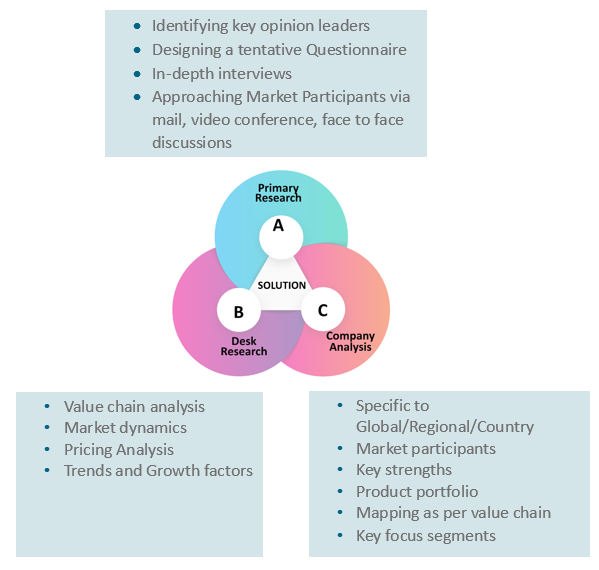
Key Inclusions
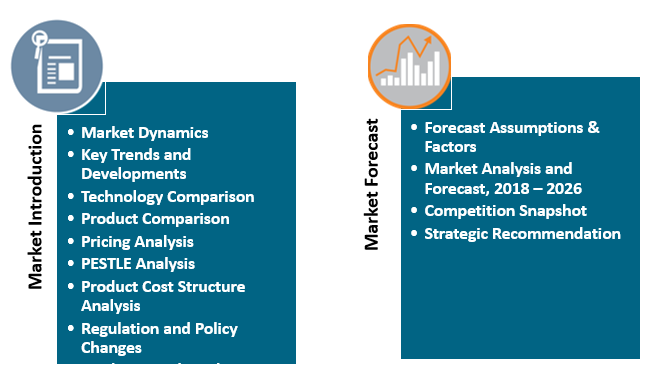
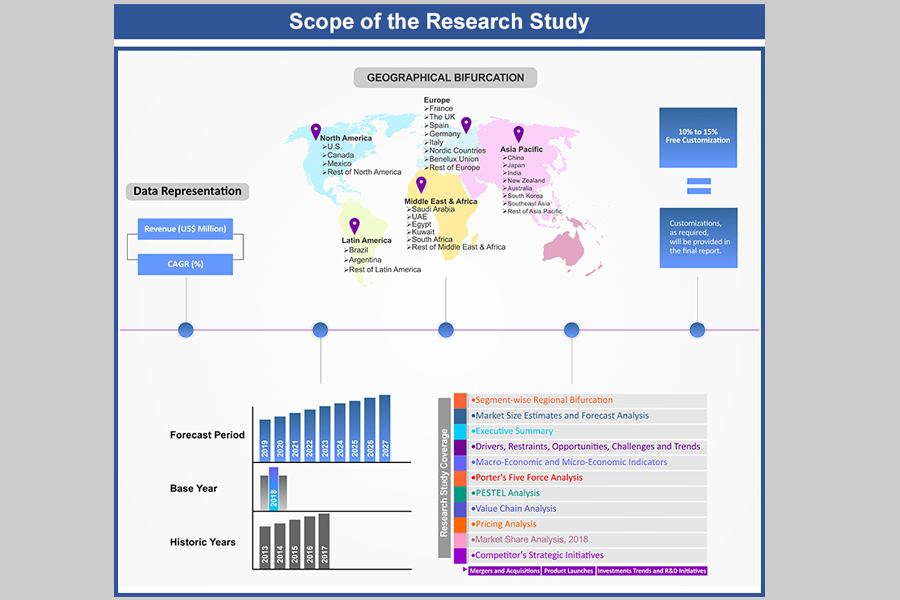
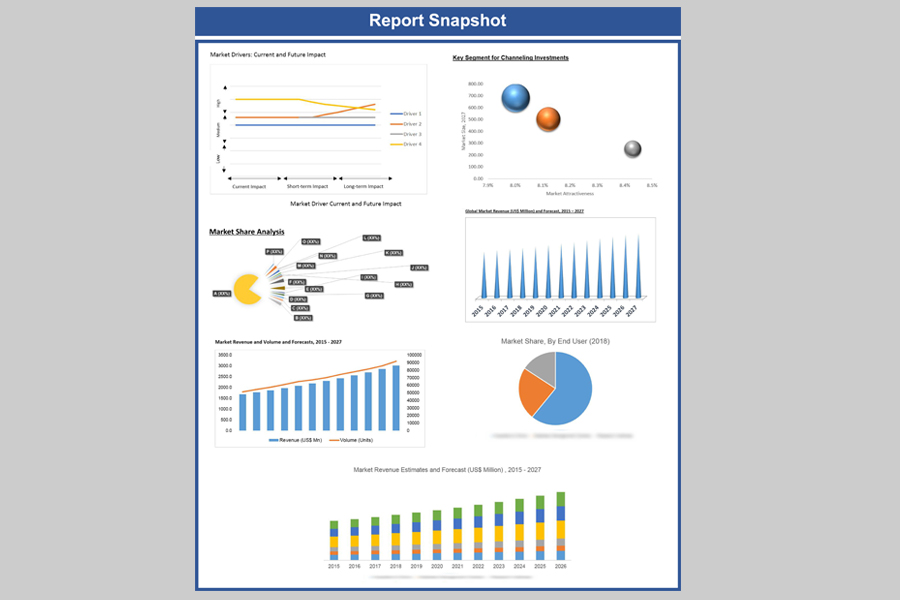
Why Absolute Markets Insights?
An effective strategy is the entity that influences a business to stand out of the crowd. An organization with a phenomenal strategy for success dependably has the edge over the rivals in the market. It offers the organizations a head start in planning their strategy. Absolute Market Insights is the new initiation in the industry that will furnish you with the lead your business needs. Absolute Market Insights is the best destination for your business intelligence and analytical solutions; essentially because our qualitative and quantitative sources of information are competent to give one-stop solutions. We inventively combine qualitative and quantitative research in accurate proportions to have the best report, which not only gives the most recent insights but also assists you to grow.


